Man and Machine: gds Sprachenwelt implements hybrid translation approach
- New translation analysis process
- Machine Translation (MT) suitability score
- “Human-in-the-Loop” approach
Sassenberg, March 11, 2020 – Fully automatic translation of text with the aid of Machine Translation (MT) has come to be particularly well-known thanks to the services of Google Translate. There are a host of factors that can affect and characterize copy in documents or technical documentation, including syntax, terminology and complexity. Whenever copy is to be translated free of errors, there is the question of whether it is possible to do so using an MT tool. gds GmbH has designed an MT Scan analysis tool for this purpose. It provides assistance with the selection of the translation method. This new tool of the full-service provider helps to minimize the cost and time associated with providing translation services while boosting efficiency.
“The MT Scan tool helps you select the best and most efficient workflow for the provision of translation services,“ said Ms. Michaela Gorisch, CEO of gds Sprachenwelt. Pure machine translation offers the advantage of high speed, but it is error-prone, especially with highly complex copy. The less the complexity, the higher the quality of automatically translated text.
“Documents can be analyzed and classified in relation to several factors, including terminology and syntax, with the aid of this new process,“ Gorisch explained and continued, “This way we can ensure high-quality, rapidly translated text with as little expense as possible so that there are no additional, unnecessary expenses for the customer.”
Prior analysis ensures higher efficiency
The MT Scan tool analyzes the text to be translated and determines an MT score. This score is then used to determine whether a document is suitable for MT. This allows us to quickly and reliably ascertain the most suitable translation process. Often we can only determine that an expert is required to adequately translate the intent behind the content during the translation process or even after machine translation has taken place. At this point, however, an efficient translation process is no longer possible.
gds GmbH is thus an advocate for the collaboration between man and machine. “A hybrid approach is often the most effective one,” according to Gorisch. This refers to a process where the document to be translated is analyzed based on the customer’s Translation Memory (TM) database. Whenever text to be translated matches already translated content to 100 percent or at least in part (fuzzy match), the translation tool will automatically populate the document with the recognized, matching translation. If the text is new to the translation memory (no match), it is machine-translated by an engine suitable for the target language. A human then reviews and edits the machine-translated text based on the customer’s terminology. Various stages of post-editing round out the translation process, dependent on quality objectives, document purpose, and budget. This Human-in-the-Loop approach of gds GmbH helps save time and money and ensures both excellent translation quality and efficiency.

Michaela Gorisch, Geschäftsführerin der gds Sprachenwelt GmbH in Hünfeld






